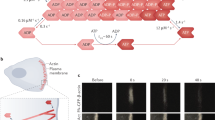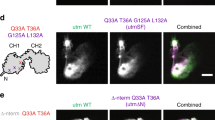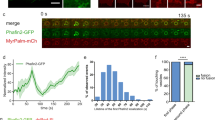Key Points
-
Although membrane rafts have often been studied using suboptimal or even improper approaches, recent studies have provided evidence in favour of a lipid compartmentalization of the plasma membrane. This was achieved either using novel and/or better-controlled techniques to visualize nanoscale molecular interactions in resting cells, or by analysing the complex membrane rearrangements that occur in an activated lymphocyte.
-
Lymphocyte migration and activation require the compartmentalization of membrane receptors and signalling molecules in specific cell locations, a process termed polarization. Cell polarization is accompanied by rapid cytoskeletal rearrangements and, at the plasma membrane, by the assembly of membrane rafts.
-
Membrane rafts have been implicated in the organization of signalling platforms that are required for the amplification of signal transduction during lymphocyte migration and activation. Interestingly, membrane-raft dynamics are controlled by co-stimulatory molecules in both B and T cells.
-
The actin cytoskeleton controls membrane-raft dynamics. By tethering and trapping membrane microdomains, the actin network influences the stability and the dimensions of membrane rafts and allows their concentration in active sites of the cell.
Abstract
The existence of plasma-membrane-raft microdomains has been widely debated during the past few years. However, it is clear that during lymphocyte stimulation a lipid-based reorganization occurs at the plasma membrane, with markers of the membrane rafts being selectively recruited to key active regions of the cell. Recent reports have demonstrated that membrane-raft dynamics are controlled by proteins that are linked to the actin cytoskeleton and have suggested a new model for the plasma membrane based on protein–lipid interactions. This new and dynamic view of the plasma membrane may improve our understanding of the complex process leading to cell polarization during lymphocyte migration and activation.
This is a preview of subscription content, access via your institution
Access options
Subscribe to this journal
Receive 12 print issues and online access
$209.00 per year
only $17.42 per issue
Buy this article
- Purchase on Springer Link
- Instant access to full article PDF
Prices may be subject to local taxes which are calculated during checkout



Similar content being viewed by others
References
Brown, D. A. & London, E. Structure and origin of ordered lipid domains in biological membranes. J. Membr. Biol. 164, 103–114 (1998).
Silvius, J. R. Role of cholesterol in lipid rafts formation: lessons from lipid model system. Biochim. Biophys. Acta 1610, 174–183 (2003).
Rodriguez-Boulan, E. & Nelson, W. J. Morphogenesis of the polarized epithelial cell phenotype. Science 245, 718–725 (1989).
Simons, K. & van Meer, G. Lipid sorting in epithelial cells. Biochemistry 27, 6197–6202 (1988).
Brown, D. A. & Rose, J. K. Sorting of GPI-anchored proteins to glycolipid-enriched membrane subdomains during transport to the apical cell surface. Cell 68, 533–544 (1992).
Cinek, T. & Horejsi, V. The nature of large noncovalent complexes containing glycosyl- phosphatidylinositol-anchored membrane glycoproteins and protein tyrosine kinases. J. Immunol. 149, 2262–2270 (1992).
Casey, P. J. Protein lipidation in cell signaling. Science 268, 221–225 (1995).
Simons, K. & Ikonen, E. Functional rafts in cell membranes. Nature 387, 569–572 (1997).
Munro, S. Lipid rafrs: elusive or illusive? Cell 115, 377–388 (2003).
Heerklotz, H. Triton promotes domain formation in lipid raft mixtures. Biophys. J. 83, 1–7 (2002).
Heerklotz, H., Szadkowska, H., Anderson, T. & Seelig, J. The sensitivity of lipid domains to small perturbations demonstrated by the effect of triton. J. Mol. Biol. 329, 793–799 (2003).
Edidin, M. The state of lipid rafts: from model membranes to cells. Annu. Rev. Biophys. Biomol. Struct. 32, 257–283 (2003).
Pizzo, P. et al. Lipid rafts and T cell receptor signaling: a critical re-evaluation. Eur. J. Immunol. 32, 3082–3091 (2002).
Lang, T. et al. SNAREs are concentrated in cholesterol-dependent clusters that define docking and fusion sites for endocytosis. EMBO J. 20, 2202–2213 (2001).
Kwik, S. et al. Membrane cholesterol, lateral mobility, and the phosphatidylinositol 4,5-bisphosphate-dependent organization of cell actin. Proc. Natl Acad. Sci. USA 100, 13964–13969 (2003).
Jacobson, K., Mouritsen, O. G. & Anderson, R. G. W. Lipid rafts: at a crossroad between cell biology and physics. Nature Cell Biol. 9, 7–14 (2007).
Subczynski, W. K. & Kusumi, A. Dynamics of raft molecules in the cell and artificial membranes: approaches by pulse EPR spin labeling and single molecule optical microscopy. Biochim. Biophys. Acta 1610, 231–243 (2003).
Liang, Y. et al. Organization of the G protein-coupled receptors rhodopsin and opsin in native membranes. J. Biol. Chem. 278, 21655–21662 (2003).
Quinn, P., Griffiths, G. & Warren, G. Density of newly synthesized plasma membrane proteins in intracellular membranes II. Biochemical studies. J. Cell Biol. 98, 2142–2147 (1984).
Takamori, S. et al. Molecular anatomy of a trafficking organelle. Cell 127, 831–846 (2006).
Anderson, R. G. & Jacobson, K. A role for lipid shells in targeting proteins to caveolae, rafts, and other lipid domains. Science 296, 1821–1825 (2002).
Kusumi, A. et al. Paradigm shift of the plasma membrane concept from the two-dimensional continuum fluid to the partitioned fluid: high-speed single-molecule tracking of membrane molecules. Annu. Rev. Biophys. Biomol. Struct. 34, 351–378 (2005).
Pike, L. J. Rafts defined: a report on the Keystone symposium on lipid rafts and cell function. J. Lipid Res. 47, 1597–1598 (2006).
Sharma, P. et al. Nanoscale organization of multiple GPI-anchored proteins in living cell membranes. Cell 116, 577–589 (2004). In this paper, the authors used fluorescence lifetime imaging microscopy to demonstrate the existence of cholesterol-sensitive domains of GPI-anchored proteins in living cells.
Suzuki, K. G. N. et al. GPI-anchored receptor clusters transiently recruit Lyn and Gα for temporary cluster immobilization and Lyn activation: single-molecule tracking study 1. J. Cell Biol. 177, 717–730 (2007).
Suzuki, K. G., Fujiwara, T. K., Edidin, M. & Kusumi, A. Dynamic recruitment of phospholipase C gamma at transiently immobilized GPI-anchored receptor clusters induces IP3-Ca2+ signaling: single-molecule tracking study 2. J. Cell Biol. 177, 731–742 (2007). In this paper, the authors used single-particle tracking to demonstrate that both protein–protein and lipid–lipid (raft) interactions are necessary during signalling through CD59 (a GPI-anchored protein).
Lauffenburger, D. & Horwitz, A. Cell migration: a physically integrated molecular process. Cell 84, 359–369 (1996).
Sanchez-Madrid, F. & del Pozo, M. Leukocyte polarization in cell migration and immune interactions. EMBO J. 18, 501–511 (1999).
Millán, J., Montoya, M., Sancho, D., Sánchez-Madrid, F. & Alonso, M. Lipid rafts mediate biosynthetic transport to the T lymphocyte uropod subdomain and are necessary for uropod integrity and function. Blood 99, 978–984 (2002).
Seveau, S., Eddy, R., Maxfield, F. & Pierini, L. Cytoskeleton-dependent membrane domain segregation during neutrophil polarization. Mol. Biol. Cell 12, 3550–3562 (2001).
Kindzelskii, A., Sitrin, R. & Petty, H. Cutting edge: optical microspectrophotometry supports the existence of gel phase lipid rafts at the lamellipodium of neutrophils: apparent role calcium signaling. J. Immunol. 172, 4681–4685 (2004).
Gómez-Moutón, C. et al. Segregation of leading-edge and uropod components into specific lipid rafts during T cell polarization. Proc. Natl Acad. Sci. USA 98, 9642–9647 (2001).
Gri, G., Molon, B., Mañes, S., Pozzan, T. & Viola, A. The inner side of T cell lipid rafts. Immunol. Lett. 94, 247–252 (2004).
Ge, S. & Pachter, J. Caveolin-1 knockdown by small interfering RNA suppresses responses to the chemokine monocyte chemoattractant protein-1 by human astrocytes. J. Biol. Chem. 279, 6688–6695 (2004).
Jiao, X., Zhang, N., Xu, X., Oppenheim, J. & Jin, T. Ligand-induced partitioning of human CXCR1 chemokine receptors with lipid raft microenvironments facilitates G-protein-dependent signaling. Mol. Cell. Biol. 25, 5752–5762 (2005).
Mañes, S., Lacalle, R., Gómez- Moutón, C. & Martínez-A, C. From rafts to crafts: membrane asymmetry in moving cells. Trends Immunol. 24, 320–326 (2003).
Fabbri, M. et al. Dynamic partitioning into lipid rafts controls the endo-exocytic cycle of the aL/b2 integrin, LFA-1, during leukocyte chemotaxis. Mol. Biol. Cell 16, 5793–5803 (2005).
del Pozo, M. A. et al. Integrins regulate Rac targeting by internalization of membrane domains. Science 303, 839–842 (2004).
Gaus, K., Le Lay, S., Balasubramanian, N. & Schwartz, M. A. Integrin-mediated adhesion regulates membrane order. J. Cell Biol. 174, 725–734 (2006).
Moffett, S., Brown, D. & Linder, M. Lipid-dependent targeting of G proteins into rafts. J. Biol. Chem. 275, 2191–2198 (2000).
Oh, P. & Schnitzer, J. E. Segregation of heterotrimeric G proteins in cell surface microdomains. Gq binds caveolin to concentrate in caveolae, whereas Gi and Gs target lipid rafts by default. Mol. Biol. Cell 12, 685–698 (2001).
Dykstra, M., Cherukuri, A., Sohn, H. W., Tzeng, S. -J. & Pierce, S. K. Location is everything: Lipid rafts and immune cell signaling. Annu. Rev. Immunol. 21, 457–481 (2003).
Davis, D. M. & Dustin, M. L. What is the importance of the immunological synapse? Trends Immunol. 25, 323–327 (2004).
Viola, A., Schroeder, S., Sakakibara, Y. & Lanzavecchia, A. T lymphocyte costimulation mediated by reorganization of membrane microdomains. Science 283, 680–682 (1999).
Gupta, N. et al. Quantitative proteomics analysis of B cell lipid rafts reveals that ezrin regulates antigen receptor-mediated lipid raft dynamics. Nature Immunol. 7, 625–633 (2006). This paper shows that BCR engagement induces the dissociation of ezrin from rafts, and proposes that, by acting as a linker to the actin cytoskeleton, ezrin regulates raft dynamics in B cells.
Von Haller, P. D., Donohoe, S., Goodlett, D. R. Aebersold, R. & Watts, J. D. Mass spectrometric characterization of proteins extracted from Jurkat T cell detergent-resistant membrane domains. Proteomics 1, 1010–1021 (2001).
Billadeau, D. D. & Burkhardt, J. K. Regulation of cytoskeletal dynamics at the immune synapse: new stars join the troupe. Traffic 7, 1451–1460 (2006).
Saint-Ruf, C. et al. Different initiation of pre-TCR and gdTCR signaling. Nature 406, 524–527 (2000).
Leitenberg, D., Balamuth, F. & Bottomly, K. Changes in the T cell receptor macromolecular signaling complex and membrane microdomains during T cell development and activation. Semin. Immunol. 13, 129–138 (2001).
Guo, B., Kato, R. M., Garcia-Lloret, M., Wahl, M. I. & Rawlings, D. J. Engagement of the human pre-B cell receptor generates a lipid raft-dependent calcium signaling complex. Immunity 13, 243–253 (2000).
Sproul, T. W., Malapati, S., Kim, J. & Pierce, S. K. B cell antigen receptor signaling occurs outside lipid rafts in immature B cells. J. Immunol. 165, 6020–6023 (2000).
Chung, J. B., Baumeister, M. A. & Monroe, J. G. Differential sequestration of plasma membrane-associated B cell antigen receptor in mature and immature B cells into glycosphingolipid-enriched domains. J. Immunol. 166, 736–740 (2001).
Sohn, H. W., Tolar, P., Jin, T. & Pierce, S. K. Fluorescence resonance energy transfer in living cells reveals dynamic membrane changes in the initiation of B cell signaling. Proc. Natl Acad. Sci. USA 103, 8143–8148 (2006). In this article, the authors used FRET to provide evidence for a selective and transient association of the BCR with a raft-targeted reporter within seconds of antigen binding.
Tavano, R. et al. CD28 interaction with filamin-A controls lipid raft accumulation at the T-cell immunological synapse. Nature Cell Biol. 8, 1270–1276 (2006). This paper demonstrates the CD28-mediated selective recruitment of a raft-targeted reporter into the T-cell immunological synapse, and provides a mechanism based on the interaction of CD28 with the actin-binding protein FLNA.
Cherukuri, A., Cheng, P. C., Sohn, H. W. & Pierce, S. K. The CD19/CD21 complex functions to prolong B cell antigen receptor signaling from lipid rafts. Immunity 14, 169–179 (2001).
Douglass, A. D. & Vale, R. D. Single-molecule microscopy reveals plasma membrane microdomains created by protein-protein networks that exclude or trap signaling molecules in T cells. Cell 121, 937–950 (2005).
Glebov, O. O. & Nichols, B. J. Lipid raft proteins have a random distribution during localized activation of the T-cell receptor. Nature Cell Biol. 6, 238–243 (2004).
Tavano, R. et al. CD28 and lipid rafts coordinate recruitment of Lck to the immunological synapse of human T lymphocytes. J. Immunol. 173, 5392–5397 (2004).
Viola, A. Amplification of TCR signaling by membrane dynamic microdomains. Trends Immunol. 22, 322–327 (2001).
Manes, S. & Viola, A. Lipid rafts in lymphocyte activation and migration. Mol. Membr. Biol. 23, 59–69 (2006).
Monks, C. R., Freiberg, B. A., Kupfer, H., Sciaky, N. & Kupfer, A. Three-dimensional segregation of supramolecular activation clusters in T cells. Nature 395, 82–86 (1998).
Mossman, K. D., Campi, G., Groves, J. T. & Dustin M. L. Altered TCR signaling from geometrically repatterned immunological synapses. Science 310, 1191–1193 (2005).
Yokosuka, T. et al. Newly generated T cell receptor microclusters initiate and sustain T cell activation by recruitment of Zap70 and SLP-76. Nature Immunol. 6, 1253–1262 (2005).
Campi, G., Varma, R. & Dustin, M. L. Actin and agonist MHC-peptide complex-dependent T cell receptor microclusters as scaffolds for signaling. J. Exp. Med. 202, 1031–1036 (2005).
Cullinan, P., Sperling, A. I. & Burkhardt, J. K. The distal pole complex: a novel membrane domain distal to the immunological synapse. Immunol. Rev. 189, 111–122 (2002).
Stossel, T. P. et al. Filamins as integrators of cell mechanics and signalling. Nature Rev. Mol. Cell Biol. 2, 138–145 (2001).
Flanagan, L. A. et al. Filamin A, the Arp2/3 complex, and the morphology and function of cortical actin filaments in human melanoma cells. J. Cell Biol. 155, 511–517 (2001).
Hayashi, K. & Altman, A. Filamin A is required for T cell activation mediated by protein kinase C-θ. J. Immunol. 177, 1721–1728 (2006).
Gupta, N. & DeFranco, A. L. Visualization of lipid raft dynamics and early signaling events during antigen receptor-mediated B cell activation. Mol. Biol. Cell 14, 432–444 (2003).
Faure, S. et al. ERM proteins regulate cytoskeleton relaxation promoting T cell–APC conjugation. Nature Immunol. 5, 272–279 (2004).
Hao, S. & August, A. Actin depolymerization transduces the strength of B cell receptor stimulation. Mol. Biol. Cell 16, 2275–2284 (2005).
Haggie, P. M., Kim, J. K., Lukacs, G. L. & Verkman, A. S. Tracking of quantum dot-labeled CFTR shows near immobilization by C-terminal PDZ interactions. Mol. Biol. Cell 17, 4937–4945 (2006).
Saad, J. S. et al. Structural basis for targeting HIV-1 Gag proteins to the plasma membrane for virus assembly. Proc. Natl Acad. Sci. USA 103, 11364–11369 (2006).
Golub, T. & Pico, C. Spatial control of actin-based motility through plasmalemmal PtdIns(4,5)P2-rich raft assemblies. Biochem. Soc. Symp. 72, 119–127 (2005).
Baumgart, T. et al. Large-scale fluid/fluid phase separation of proteins and lipids in giant plasma membrane vesicles. Proc. Natl Acad. Sci. USA 104, 3165–3170 (2007).
Acknowledgements
We thank M. Necci for assistance with original graphics and our colleagues for discussions. N.G. is the recipient of a K01 mentored research career development award (DK068,292) from NIDDK. A.V. is supported by grants from the Italian Association for Cancer Research (AIRC), MIUR/COFIN, the Cancer Research Institute of New York, the Department of Defense Prostate Cancer Research Program and the EMBO Young Investigator Programme. We apologize to colleagues whose work is cited via review rather than original work owing to space restraints.
Author information
Authors and Affiliations
Related links
Glossary
- Membrane rafts
-
Small (10–200 nm in diameter), heterogeneous, highly dynamic, sterol- and sphingolipid-enriched membrane domains that can sometimes be stabilized to form larger platforms through protein–protein and protein–lipid interactions. Considering the new definition and the recent literature, the term 'membrane rafts' is preferable to 'lipid rafts'.
- Detergent-resistant membranes
-
(DRMs). The low-density fractions obtained after the sucrose density gradient ultracentrifugation of detergent-lysed cells. In general, a neutral detergent solution at 4°C is used. The term DRM is not synonymous with membrane raft.
- Lipid miscibility
-
The property of different lipids to mix and form homogeneous lipid phases. Sphingolipid–cholesterol rafts are considered to be liquid-ordered-phase domains that are dispersed in a liquid crystalline bilayer.
- Membrane potential
-
The electrical-potential difference (voltage) across a cell's plasma membrane, which arises from the separation of positive and negative charges across the membrane owing to the action of ion transporters that maintain controlled ion concentrations inside the cell.
- Fluorescence resonance energy transfer
-
(FRET). A quantum mechanical process by which excitation energy is transferred, without the emission of a photon, from a donor fluorophore to an acceptor fluorophore that is in close proximity. FRET can be used to analyse molecular interactions (in the range of 10–100 Å).
- Immunological synapse
-
The specialized contact area between a T cell and one or more antigen-presenting cells, which is dynamic, and shows lipid and protein segregation, signalling compartmentalization and bidirectional information exchange through soluble and membrane-bound transmitters.
- B-cell receptor capping
-
The binding of multivalent ligands to B-cell receptors induces redistribution and aggregation of the bound receptors into patches. Capping, which requires metabolic energy and cytoskeleton dynamics, represents the coalescence of patches to form a single aggregate called cap.
Rights and permissions
About this article
Cite this article
Viola, A., Gupta, N. Tether and trap: regulation of membrane-raft dynamics by actin-binding proteins. Nat Rev Immunol 7, 889–896 (2007). https://doi.org/10.1038/nri2193
Issue Date:
DOI: https://doi.org/10.1038/nri2193
This article is cited by
-
Myconoside interacts with the plasma membranes and the actin cytoskeleton and provokes cytotoxicity in human lung adenocarcinoma A549 cells
Journal of Bioenergetics and Biomembranes (2022)
-
Xanthomonas effector XopR hijacks host actin cytoskeleton via complex coacervation
Nature Communications (2021)
-
CMIP is a negative regulator of T cell signaling
Cellular & Molecular Immunology (2020)
-
Organization and dynamics of functional plant membrane microdomains
Cellular and Molecular Life Sciences (2020)
-
Roles of GalNAc-disialyl Lactotetraosyl Antigens in Renal Cancer Cells
Scientific Reports (2018)



